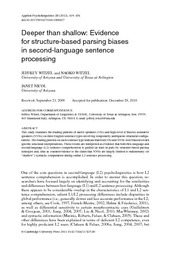
ATTENTION: The works hosted here are being migrated to a new repository that will consolidate resources, improve discoverability, and better show UTA's research impact on the global community. We will update authors as the migration progresses. Please see MavMatrix for more information.
Show simple item record
| dc.contributor.author | Witzel, Naoko | |
| dc.contributor.author | Witzel, Jeffrey | |
| dc.contributor.author | Nicol, Janet | |
| dc.date.accessioned | 2014-03-06T21:55:17Z | |
| dc.date.available | 2014-03-06T21:55:17Z | |
| dc.date.issued | 2012 | |
| dc.identifier.citation | Published in Applied Psycholinguistics 33:419–456, 2012 | en_US |
| dc.identifier.issn | 0142-7164 | |
| dc.identifier.uri | http://hdl.handle.net/10106/24009 | |
| dc.description.abstract | This study examines the reading patterns of native speakers (NSs) and high-level (Chinese) nonnative
speakers (NNSs) on three English sentence types involving temporarily ambiguous structural configurations. The reading patterns on each sentence type indicate that both NSs and NNSs were biased toward
specific structural interpretations. These results are interpreted as evidence that both first-language and
second-language (L2) sentence comprehension is guided (at least in part) by structure-based parsing
strategies and, thus as counterevidence to the claim that NNSs are largely limited to rudimentary (or
“shallow”) syntactic computation during online L2 sentence processing. | |
| dc.language.iso | en_US | en_US |
| dc.publisher | Cambridge University Press | en_US |
| dc.subject | Reading patterns | en_US |
| dc.subject | Second-language psycholinguistics | en_US |
| dc.subject | Sentence comprehension | en_US |
| dc.title | Deeper than shallow: Evidence for structure-based parsing biases in second-language sentence processing | en_US |
| dc.type | Article | en_US |
| dc.publisher.department | Department of Linguistics & TESOL, The University of Texas at Arlington | en_US |
| dc.identifier.externalLinkDescription | The original publication is available at Article DOI | en_US |
| dc.identifier.doi | doi:10.1017/S0142716411000427 | |
Files in this item
- Name:
- Witzel1.pdf
- Size:
- 173.6Kb
- Format:
- PDF
- Description:
- PDF
This item appears in the following Collection(s)
Show simple item record


